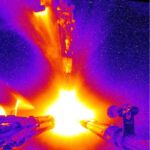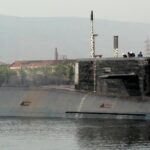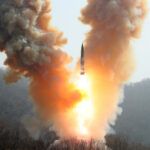Nuclear weapons sharing, 2023
By Hans M. Kristensen, Matt Korda, Eliana Johns, Mackenzie Knight | November 8, 2023
Nuclear weapons sharing, 2023
By Hans M. Kristensen, Matt Korda, Eliana Johns, Mackenzie Knight | November 8, 2023
The Nuclear Notebook is researched and written by the staff of the Federation of American Scientists’ Nuclear Information Project: director Hans M. Kristensen, senior research fellow Matt Korda, research associate Eliana Johns, and Scoville fellow Mackenzie Knight. The Nuclear Notebook column has been published in the Bulletin of the Atomic Scientists since 1987. This issue’s column examines the current state of global nuclear sharing arrangements, which include non-nuclear countries that possess nuclear-capable delivery systems for employment of a nuclear-armed state’s nuclear weapons.
This article is freely available in PDF format in the Bulletin of the Atomic Scientists’ digital magazine (published by Taylor & Francis) at this link. To cite this article, please use the following citation, adapted to the appropriate citation style: Hans M. Kristensen, Matt Korda, Eliana Johns, and Mackenzie Knight, Nuclear weapons sharing, 2023, Bulletin of the Atomic Scientists, 79:6, 393-406, DOI: https://doi.org/10.1080/00963402.2023.2266944
To see all previous Nuclear Notebook columns, go to https://thebulletin.org/nuclear-notebook.
Collectively, the world’s estimated 12,512 nuclear warheads belong to just nine countries. However, there are more than two dozen additional countries that participate in nuclear mission-related arrangements. While these countries do not have direct launch authority over any nuclear warheads, they play an important role in their storage, planning, delivery, and safety and use-control, and therefore merit a degree of scrutiny alongside their nuclear-armed peers.
Nuclear sharing: what it is and is not
A common misconception surrounding nuclear sharing is that it refers to one country simply handing its nuclear weapons or launch authority to another country. While there have been specific instances during the Cold War when the United States’ allies maintained a relatively high degree of control over the nuclear weapons stationed on their soil, this is no longer the case in peacetime.
Nuclear sharing, not to be confused with burden sharing, generally refers to the practice of allowing non-nuclear countries to operate specially configured launchers to employ a nuclear-armed state’s nuclear weapons in time of war. The nuclear sharing mission is a subset of a much broader range of nuclear-related activities that can take several forms (see also Figure 1):
- Maintain nuclear forces to provide nuclear protection for non-nuclear countries;
- Permanently hosting another country’s nuclear weapons or delivery systems;
- Providing delivery systems to be capable of employing another country’s nuclear weapons;
- Providing conventional capabilities to support another country’s nuclear strike mission; or
- Cooperating with another country on nuclear planning and targeting.
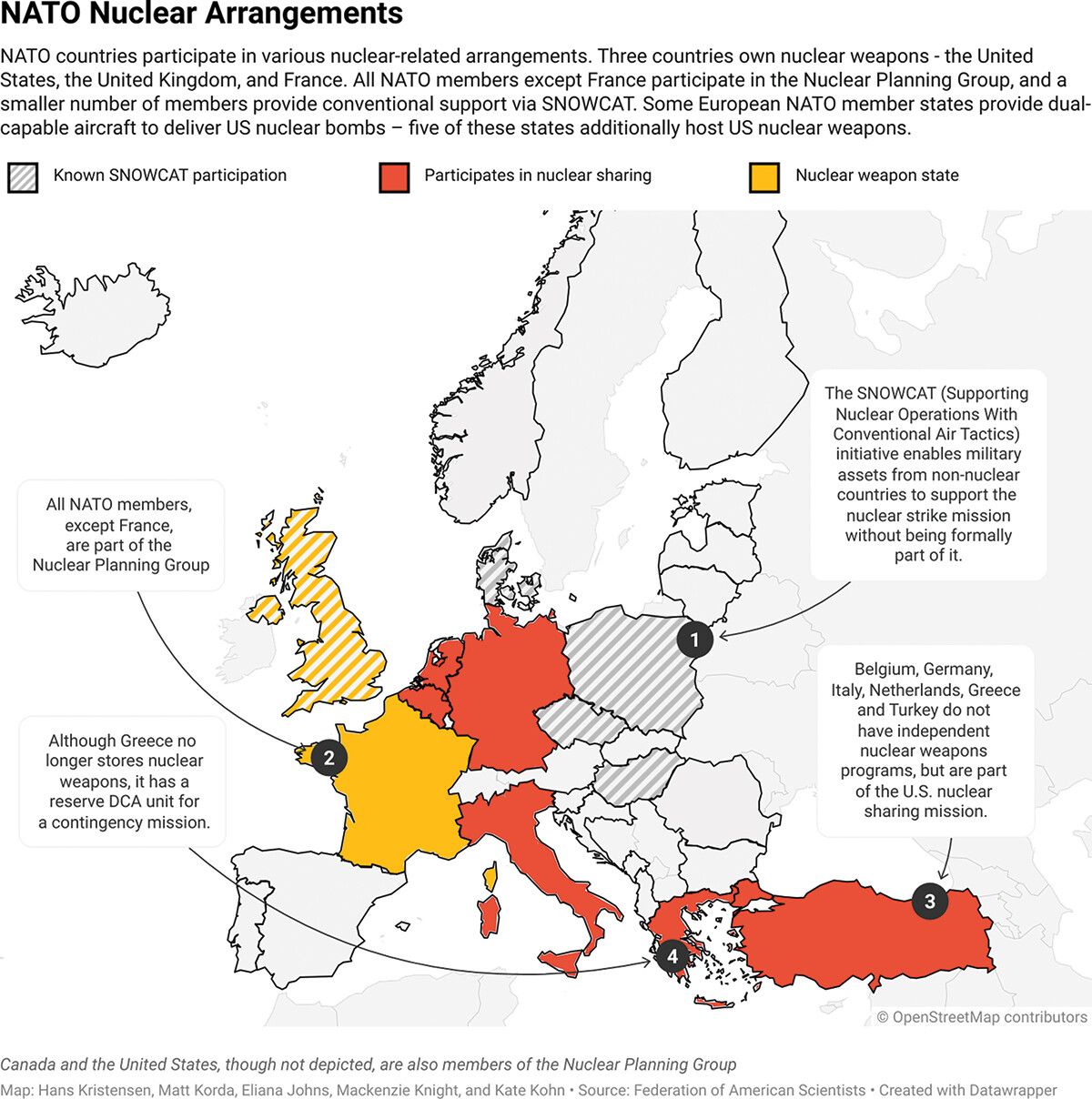
In recent years, nuclear sharing arrangements have reentered the international spotlight. The United States is modernizing the infrastructure that supports its nuclear sharing mission in Europe and is preparing to deploy its new B61-12 gravity bombs to European air bases for delivery by US and allied aircraft. Meanwhile, following its invasion of Ukraine in 2022, Russia says it is transferring nuclear-capable delivery systems to Belarus, training Belarusian military personnel on how to use them, and claiming to have deployed Russian nuclear weapons on Belarusian territory.
Participation in nuclear-related arrangements will increase in the coming years, as new NATO members Sweden and Finland join the Alliance’s Nuclear Planning Group and potentially decide to participate in NATO’s annual nuclear strike exercise, and countries like Poland and South Korea have advocated a role in the United States’ nuclear mission as well.
US-NATO nuclear sharing
The governance of US nuclear weapons deployments in Europe is administered through distinct types of parallel agreements with the host or “user nation:”
- An Atomic Cooperation Agreement governs the bilateral exchange of atomic information. An example of this type of agreement is the 1958 US-UK Mutual Defense Agreement, which allows the United States and United Kingdom to exchange nuclear materials, technology, and information.
- An Atomic Stockpile Agreement is an agreement between the United States and a “user nation” governing the introduction, storage, custody, security, safety, and release of US nuclear weapons. Examples of this type of agreement include the bilateral agreements between the United States and its NATO allies that currently host US nuclear weapons.
- A Service-Level Agreement is a technical agreement between the military services of the United States and the “user nation.” They serve to provide detailed instructions and processes for implementing the Atomic Stockpile Agreements. While the details of these agreements are highly classified, some of their codenames are known: Pine Cone for Belgium, Toolchest for Germany, Stone Ax for Italy, and Toy Chest for the Netherlands (Kristensen 2005).
In addition to the actual storage and maintenance of nuclear weapons, seven NATO member states (NATO 2022b)—Belgium, Germany, Italy, the Netherlands, the United States, as well as Turkey and Greece (in a reserve and contingency role) (Kristensen 2022b)—contribute “Dual-Capable Aircraft” (DCA) to NATO’s nuclear mission. These aircraft could be used to deliver nuclear weapons in a conflict.
Five NATO countries currently host a total of six bases that store US nuclear bombs in underground storage vaults. Several other bases have empty storage vaults in inactive status. One of these (RAF Lakenheath in England) is being renovated to potentially store nuclear bombs in the future, if NATO decides to do so (Korda and Kristensen 2023).
Six additional NATO members—the Czech Republic, Denmark, Hungary, Poland, and two unknown countries—play a supporting role in NATO’s nuclear posture through the “SNOWCAT” mission (“Support of Nuclear Operations With Conventional Air Tactics”), alongside the DCA-contributing countries.
All NATO member states—with the notable exception of France, which also has nuclear weapons of its own—participate in NATO’s Nuclear Planning Group (NPG), which governs collective policy- and decision-making over NATO’s nuclear mission.
Nuclear sharing during the Cold War
In July 1953, the United States committed theater nuclear weapons to NATO, with the first warheads arriving in Europe in September 1954 (Alberque 2017, 13; Burr 2020a). Following the integration of nuclear weapons into NATO strategy via the approval of Military Committee 48 (MC 48), the Eisenhower administration conducted courses and trainings for NATO senior officers on the use of atomic weapons and began considering nuclear stockpile agreements (Burr 2020a).
Concerns over the Soviet launch of the Sputnik satellite in October 1957 brought urgency to the discussions on nuclear sharing within NATO, leading to a US Joint Chiefs of Staff (JCS) proposal for NATO nuclear stockpile arrangements in December 1957 (Alberque 2017, 13–14). Under the agreement, the United States would maintain control and custody of the weapons, and the president possessed sole authority for their launch. However, the president could delegate authority to the NATO Supreme Allied Commander (SACEUR) to use the weapons in the case of war (US Congress 1961). The warheads and their delivery vehicles had to remain separate and unarmed until the United States released the warheads for launch and, once released, the weapons would be under NATO control (Alberque 2017, 14). The North Atlantic Council (NAC) agreed to the JCS proposal, which became NATO’s first formal nuclear arrangement (NATO 1957).
US nuclear weapons deployed to Europe were kept under US custody and control and would only be released to the user nation in a nuclear crisis. The United States maintained at least one US “custodian” who was present at all times with the weapons and classified material, during their transport, and when loaded on aircraft or mated with delivery vehicles. Despite US custodianship, security of the nuclear weapons was the responsibility of the user nation (US Congress 1961).
In 1960, a Joint Congressional Committee on Atomic Energy investigation found that, in many cases, the aforementioned control procedures existed more in theory than in practice. In some cases, allies possessed the ability to launch the weapons on their own, particularly the weapons on Quick Reaction Alert aircraft. The committee additionally found that the JCS and Defense Department had entered into nuclear cooperation or stockpile agreements with allies outside of the recognized legal avenues without notifying Congress (Office of the Assistant to the Secretary of Defense (Atomic Energy) 1978, 74).
The committee’s findings prompted President Kennedy to temporarily halt deployment of nuclear weapons to NATO allies until the security of those weapons was improved (Burr 2020b), and the recommendations led to the development of Permissive Action Links (PALs), a combination of an electronic code system and physical hardware placed on or within the weapons to prevent their unauthorized use (The White House 1962).
After first being introduced in 1962, American nuclear security expert Bruce Blair wrote that PALs could be easily bypassed for the next 15 years, given that it was apparently an open secret that the unlock code was set to “00000000” (Blair 2004). According to Blair, the PALs were correctly activated in 1977, and today, the most modern PALs include 6- or 12- digit electronically-coded locks, microprocessors, coded switches, and a mechanism that disables the weapon if too many incorrect attempts are made (Office of the Deputy Assistant Secretary of Defense for Nuclear Matters 2020).
At the peak in 1971, the United States deployed more than 7,000 nuclear weapons in Europe, including Belgium, Greece, Italy, the Netherlands, Turkey, the United Kingdom, and West Germany. Starting in 1991-1992, the United States withdrew all its ground-launched and naval tactical nuclear weapons from Europe, leaving 700 nuclear gravity bombs behind. The United States then consolidated many of these weapons to a smaller number of European bases; between 1985 and 1995, the number of nuclear air bases in Europe was reduced from 23 to 16 (Kristensen 1995; see also Figure 2). By 2000, there were 480 bombs left, a number that dropped to 180 around 2007.
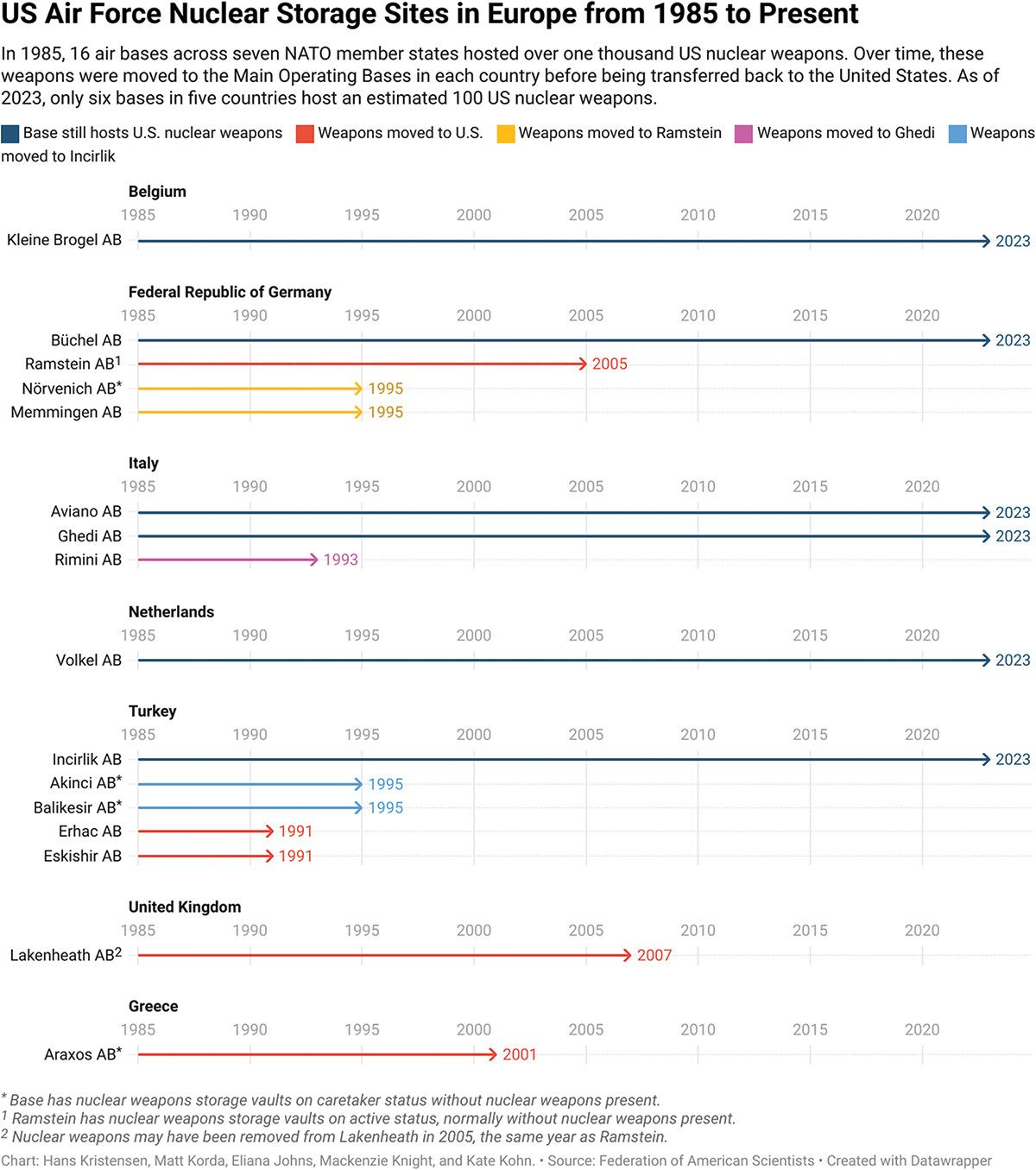
Nuclear sharing today
Today, approximately 100 US nuclear weapons are estimated to be stored at six bases in five countries, with one additional base (RAF Lakenheath) currently undergoing modernization to potentially store nuclear weapons in the future.
The United States is preparing to replace all legacy versions of the B61 gravity bomb deployed in Europe with the incoming B61-12, which uses a modified version of the warhead used in the current B61-4 gravity bomb. In addition to US heavy bombers, the B61-12 will also be integrated onto US- and allied-operated tactical aircraft, including the F-15E, the F-16C/D, the F-16MLU, the PA-200 Tornado, and the F-35A. Except for Turkey, every NATO country that hosts US nuclear weapons is purchasing the F-35A to replace their legacy aircraft. However, because of their age and logarithmic systems, these older aircraft will not be able to benefit from the increased accuracy provided by the B61-12ʹs new digital guided tail kit. Instead, it will deliver the bomb as a “dumb” bomb akin to the current B61-3s and B61-4s, but without a parachute-retarted laydown option.
Each year, NATO practices its nuclear sharing arrangements in a two-week-long exercise known as “Steadfast Noon,” hosted by a different NATO member state each year. The most recent iteration of the exercise, which was hosted by Belgium, involved 14 countries and up to 60 aircraft and practiced the employment of US nuclear weapons by NATO DCA (NATO 2022a).
—Kleine Brogel Air Base, Belgium
Kleine Brogel Air Base (51.1685, 5.4666) hosts an estimated 10-15 US B61 nuclear bombs for delivery by Belgian F-16MLU aircraft.
A total of 11 protective aircraft shelters are equipped with a Weapons Storage and Security System (WS3) that includes an elevator-drive Weapon Storage Vault (WSV)—as well as the associated command, control, and communications software needed to unlock the weapons—that can be lowered into the concrete floor. Each WSV can hold up to four bombs, for a maximum base capacity of 44 weapons.
In recent years, certain areas within Kleine Brogel have been expanded and modernized (Figure 3). Construction has taken place within the support area for the 701st Munitions Support Squadron (MUNSS)—the US Air Force squadron responsible for the physical security and maintenance of the weapons, as well as for delivering custody of the weapons to the user country’s air forces if directed to do so. This includes a new drive-through facility for nuclear weapons maintenance trucks. In addition, a large tarmac for C-17A nuclear transport aircraft has been added next to the presumed nuclear weapons area, construction of a high-security underground facility has been nearly completed, a new control tower has been added, and underground cables and the Alarm Communication & Display (AC&D) system have been upgraded, which all have been visible on satellite imagery.
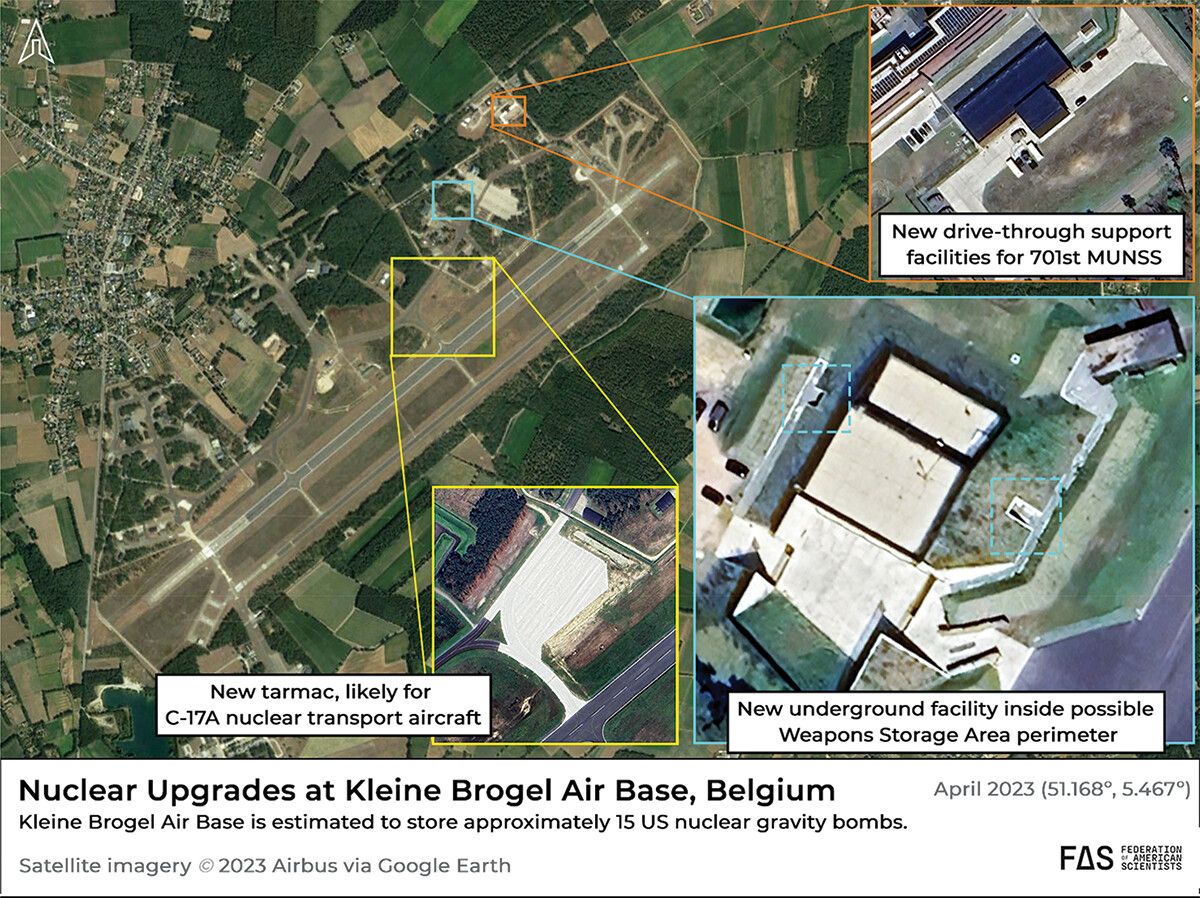
—Volkel Air Base, the Netherlands
Volkel Air Base (51.6577, 5.7016) hosts an estimated 10-15 US B61 US nuclear bombs for delivery by Dutch F-16MLU aircraft.
There are 32 protective aircraft shelters at Volkel Air Base, 11 of which are equipped with WS3s for nuclear weapons storage. Each WSV can hold up to four bombs, for a maximum base capacity of 44 weapons.
Recent construction at Volkel Air Base has focused on several new additions. Most notably, over the past two years, a tarmac area with a high wall has been constructed near several aircraft shelters. This area is likely intended for use by the C-17A Globemaster III—the only transport aircraft authorized to move the US Air Force’s nuclear weapons—to provide additional flexibility and facilitation for rapidly moving nuclear weapons on- and off-base (Kristensen 2023). In addition, a high-security building similar to the one being added to Kleine Brogel has been completed.
Similar security-related construction upgrades to those at other nuclear weapons bases in Europe have been visible on satellite imagery at Volkel Air Base.
—Büchel Air Base, Germany
Büchel Air Base (50.1762, 7.0640) hosts an estimated 10-15 US B61 nuclear bombs for delivery by German PA-200 Tornado aircraft.
A total of 11 protective aircraft shelters at Büchel Air Base are equipped with WS3s for nuclear weapons storage. Each WSV can hold up to four bombs, for a maximum base capacity of 44 weapons.
The entire runway at Büchel Air Base has been under construction since September 2022. In the meantime, the Tactical Air Wing 33’s Tornado aircraft are being hosted at Nörvenich Air Base and Spangdahlem Air Base (Sanchez-Chen 2023). There also appears to be construction taking place within the loops housing the base’s protective aircraft shelters. In addition, a new walled tarmac area is being built, like the one under construction at the Kleine Brogel, Volkel, and Gherdi air bases.
Similar security-related construction upgrades to those at other nuclear weapons bases in Europe have been visible on satellite imagery at Büchel Air Base.
—Aviano Air Base, Italy
Aviano Air Base (46.0313, 12.5968) hosts an estimated 20-30 US B61 nuclear bombs for delivery by US F-16C/D aircraft. Aviano Air Base is home to the 31st Fighter Wing with its two squadrons of nuclear-capable aircraft: the 510th “Buzzards” Fighter Squadron and the 555th “Triple Nickel” Fighter Squadron.
A total of 18 underground nuclear weapons storage vaults were installed in as many protective aircraft shelters at Aviano in 1996. Of Aviano’s 18 storage vaults, only 11 are estimated to be active, all of which are inside a security perimeter that was built in 2015. Each WSV can hold up to four bombs, for a maximum base capacity of 44 weapons.
A significant upgrade of the area with the active nuclear weapons shelters was completed in 2014-2015.
—Ghedi Air Base, Italy
Ghedi Air Base (45.4319, 10.2670) hosts an estimated 10-15 US B61 nuclear bombs for delivery by Italian PA-200 Tornado aircraft.
There are 22 protective aircraft shelters at Ghedi Air Base, divided into two groups of 11 on the northwestern and southeastern ends of the airfield. A new double-fenced high-security perimeter was built around the northwestern shelters in 2020, suggesting that this group remains active.
Ongoing construction includes, a new tarmac and shelter area for Italy’s incoming F-35A aircraft, a new drive-through support building for nuclear weapons maintenance trucks at the 704th MUNSS area, as well as a new tarmac for C-17A transport aircraft outside the nuclear weapons storage area.
—Incirlik Air Base, Turkey
Incirlik Air Base (37.0025, 35.4267) hosts an estimated 20-30 US B61 nuclear bombs for delivery by US aircraft; however, unlike at other bases, Turkey does not allow the United States to permanently base its bomber aircraft at Incirlik. As a result, US aircraft would have to fly in during a crisis to pick up the weapons, or the weapons would have to be shipped to other locations before use.
In 2015, a new security perimeter was constructed around 21 protective aircraft shelters within Incirlik Air Base, suggesting that these are currently active. Despite reports that the Pentagon has previously reviewed plans for removing US nuclear weapons from Turkey due to security concerns (Sanger 2019), the nuclear mission was heavily implied to still be in effect at Incirlik Air Base as recently as July 2023, when USAFE A10 senior leaders visited Incirlik to discuss the “surety mission” and “the role that Incirlik [Air Base] plays in strategic deterrence” (Myricks 2023). (“Surety” is a term commonly used by the Pentagon and the Department of Energy to refer to the capability to keep nuclear weapons safe, secure, and under positive control, while the A10 office is the Air Force’s office for “Strategic Deterrence and Nuclear Integration.”)
—Lakenheath Royal Air Force Base, United Kingdom
The United States stored nuclear weapons in the United Kingdom from 1954 until approximately 2007, when they were withdrawn from RAF Lakenheath (Kristensen 2008). Over the past two years, however, increasing evidence has suggested that the US Air Force may be upgrading RAF Lakenheath to be capable of storing nuclear bombs, if it decided to do so (Korda and Kristensen 2023).
The Air Force’s fiscal year 2024 budgetary justification package, dated March 2023, notes the planned construction of a “surety dormitory” at RAF Lakenheath, approximately 100 kilometers northeast of London (US Air Force 2023). The “surety dormitory” was also briefly mentioned in the Department of Defense’s testimony to Congress in March 2023, but with no accompanying explanation (Owens 2023).
This note follows the United Kingdom’s addition to the Department of Defense’s fiscal year 2023 budgetary documents for the NATO Security Investment Program, in which it was written that “NATO is wrapping up a thirteen-year, $384 million infrastructure investment program at storage sites in Belgium, Germany, the Netherlands, the United Kingdom, and Turkey to upgrade security measures, communication systems, and facilities” (Kristensen 2022a; US Department of Defense 2022, 8; emphasis added). An explicit mention of the United Kingdom had not been included in the previous year’s budgetary documents (US Department of Defense 2021, 7), and it was removed in this year’s documents after we reported on its inclusion the previous year (US Department of Defense 2023, 7).
While it remains unclear whether the United States intends to permanently store nuclear weapons at RAF Lakenheath, the groundwork is apparently being laid for the base to receive nuclear weapons—potentially from other European bases—during a crisis.
Nuclear sharing and the Nuclear Non-Proliferation Treaty
NATO’s nuclear sharing arrangements are intimately linked with the United States’ and the Soviet Union’s negotiations on the Nuclear Non-Proliferation Treaty (NPT) during the 1960s. Discussions on a treaty addressing nuclear proliferation began in the early 1960s and were conducted alongside discussions within NATO on “hardware” and “software” solutions (e.g. consultation, planning, training). Statements and letters between the United States and the Soviet Union were exchanged throughout 1965 and 1966 in an attempt to understand each side’s position. Finally, in 1966, the Soviets clarified that they were not concerned with nuclear software arrangements in NATO, and the United States assured that it would never give up its veto over the launch of its own nuclear weapons (Alberque 2017). Articles I and II of the NPT were ultimately written jointly by the United States and the Soviet Union to satisfy NATO’s existing nuclear arrangements and the Soviet Union’s demand that West Germany not be given nuclear control or authority (Alberque 2017).
Despite the joint agreement between the United States and the Soviet Union, over the past decade, Russia has repeatedly accused the United States and its NATO Allies of being in violation of both Articles I and II of the NPT (Uliyanov 2015).
Nuclear authorization and consultation
NATO itself has no ownership of nuclear weapons, and therefore no authority to launch them. This decision can only be made by the leaders of its nuclear-armed member states, and particularly by the United States, which retains ownership and authority over the B61 gravity bombs that are assigned to NATO DCA.
A NATO factsheet published in 2022 noted that “a nuclear mission can only be undertaken after explicit political approval is given by NATO’s Nuclear Planning Group (NPG) and authorization is received from the US President and UK Prime Minister” (NATO 2022b). It is unclear, however, why the UK Prime Minister would be necessary to authorize the release of US nuclear weapons. Moreover, this degree of consultation would likely face significant challenges during an actual conflict.
Throughout the early Cold War, NATO allies continuously sought assurances from the United States that its nuclear weapons would not be used without prior consultation. For its part, the United States sought to preserve its own freedom of action, as well as its position that no president would allow a veto power over US nuclear use.
This push-and-pull dynamic eventually resulted in the 1962 Athens Guidelines, in which NATO allies acknowledged that possibilities for consultation would likely be “extremely limited” in the event of a nuclear crisis, but that the United States would work to consult with its NATO allies prior to nuclear release “if time permitted” (North Atlantic Council 1962). Channels and procedures for consultation with allies were subsequently established: A request or proposal to use nuclear weapons would be communicated to the NAC/DPC, where countries could express their views on the proposed use. However, “special weight would be given to the views of the NATO country most directly affected,” meaning the country or countries providing the warheads and delivery vehicles and from whose territory the weapons would be used (Congressional Research Service 1975, 7–8).
It is difficult to imagine an actual situation wherein all NATO allies would be able to agree on nuclear use unless a NATO member had already been attacked with nuclear weapons. It is similarly difficult to imagine that, in the midst of a full-scale nuclear exchange, there would be time for high-level consultation. When reflecting on NATO’s crisis communications infrastructure in 1989, Australian nuclear expert Des Ball once remarked: “It is difficult to envisage a decision-making process or a [Command, Control, Communications and Information] system as complex or as less capable of functioning in a timely and responsive manner than that of NATO” (Ball 1989, 306).
Russia-Belarus nuclear sharing
Shortly after its founding, the Soviet Union first deployed nuclear weapons to East Germany in 1959, and then to other Soviet republics and satellite states (Becz, Kizmus, and Várhegyi 2019, 242). In 1979, NATO estimated that there were between 30 and 35 Soviet nuclear storage sites in Eastern Europe, at least half of which permanently housed nuclear weapons (Becz, Kizmus, and Várhegyi 2019, 12).
Following the collapse of the Soviet Union in 1991, more than 6,000 nuclear weapons were suddenly left behind on former Soviet territories: Belarus, Kazakhstan, and Ukraine in particular found themselves as owners of some of the world’s largest nuclear arsenals. These three countries agreed to transfer all nuclear weapons left on their territories back to Russia and accede to the NPT as non-nuclear weapons states. The last of these nuclear weapons was transferred back to Russia in November 1996, and many of the old nuclear storage sites in these countries were mothballed, repurposed, or left abandoned (Mirovich 2019).
More than 25 years later, it appears that Russia has resumed the practice of deploying nuclear weapons abroad. In February 2022, only a few days before Russia’s invasion of Ukraine, Russian President Vladimir Putin and Belarusian President Alexander Lukashenko made numerous statements about equipping Belarusian forces with the capability to employ Russian nuclear weapons, with Lukashenko stating on February 17 that he would ask Putin to set up a training center for Iskander-M ballistic missiles in Belarus (Republic of Belarus 2022). Then, on February 26, the Belarusian parliament approved a new constitution that removed a previous ban on nuclear weapons on Belarusian territory (Williams and Ljunggren 2022).
On June 25, 2022, Putin promised to “hand over a number of tactical missile systems” to Belarus, specifically noting that “they can fire ballistic and cruise missiles with conventional and nuclear warheads.” He also told Lukashenko that Belarusian Su-25 aircraft “could be upgraded” to deliver Russian nuclear weapons. In that same meeting, however, Putin noted that there would be “no need” to “reciprocate” NATO’s nuclear sharing posture by placing nuclear weapons in Belarus (President of Russia 2022). On December 19, 2022, Lukashenko claimed that the Russian Iskander short-range ballistic missiles were now operational and had been placed on “combat duty” in Belarus (Adamowski 2022).
In the spring of 2023, it became clear that Putin planned to reverse his position and would soon begin the process of storing nuclear weapons on Belarusian soil. In February 2023, the CIA assessed that a senior officer from the Russian Ministry of Defence inspected a facility in the vicinity of Asipovichy—near the new Iskander-M training site in Belarus—for potential upgrades. One month later, Putin publicly walked back his previous position and announced that Russia would “finish construction of a special storage facility for tactical nuclear weapons on the territory of Belarus” by July 1, 2023 (Guardian News 2023). Satellite imagery from around this time revealed the start of land-clearing for a new security perimeter at a former 12th GUMO unit depot east of Asipovichy (Figure 4).
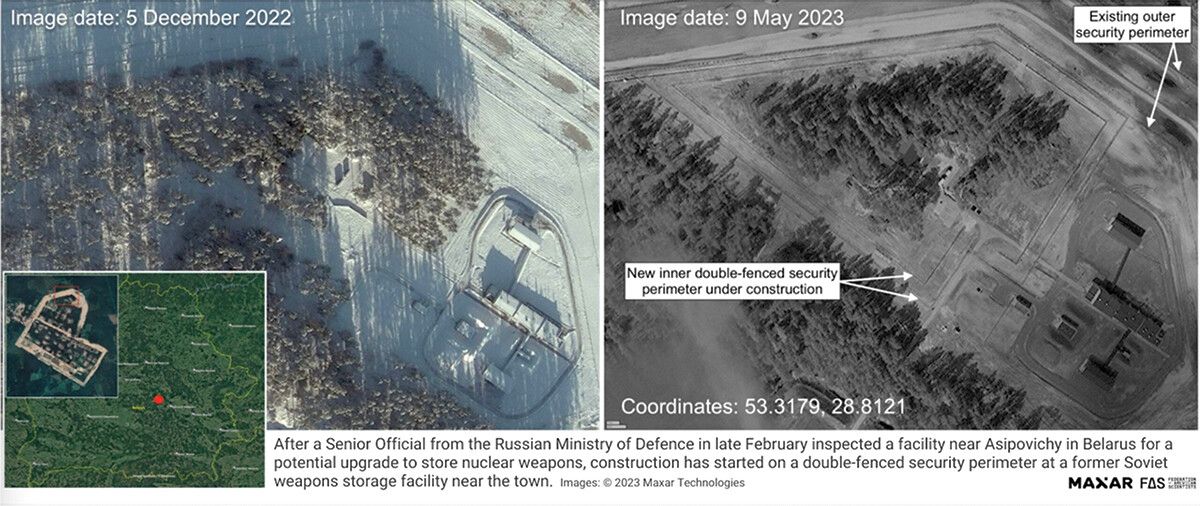
On March 25, 2023, Putin formally announced that Russia would deploy tactical nuclear weapons in Belarus. During his announcement, Putin pointed to the United States’ deployment of tactical nuclear weapons to NATO countries as justification for establishing a Russian nuclear sharing arrangement with Belarus:
- There is nothing unusual here … firstly, the United States have been doing this for decades. They have long ago deployed their tactical nuclear weapons on the territory of their allied countries … the Americans do this with their allies, deploy on their territory, teach, by the way, their crews, their pilots to use this type of weapons if necessary. We agreed that we will do the same—without violating our obligations. (Guardian News 2023)
Belarusian pilots and missile crews reportedly began their training in Russia in early April 2023, and on April 14, the Belarusian Ministry of Defense published a video that appeared to show a Su-25 pilot explaining his new role in delivering “special [nuclear] munitions” following training in Russia (ASTRA 2023). The video was geolocated by the Federation of American Scientists to Lida Air Base in western Belarus (Korda, Johns, and Kristensen 2023). This two-week period constitutes an unusually fast turnaround for completing the certification process; by contrast, nuclear certification for US/NATO nuclear weapon systems can take months (Steele 2012), or even years (F-35 Joint Program 2022). The rushed training and certification process adds an additional layer of confusion to an already murky situation. Although limited perimeter construction is visible at Lida Air Base, it does not appear sufficient for nuclear weapons storage.
In May 2023, as satellite imagery suggested that the new double-fenced security perimeter at the Asipovichy depot was nearing completion (Kristensen and Korda 2023), Russia and Belarus reportedly signed documents detailing the procedures for storing Russian non-strategic nuclear weapons in a special storage facility in Belarus (Belta 2023c). Putin then stated in a meeting with Lukashenko in June that “on July 7–8 the preparations of the relevant facilities will be completed. We will immediately begin activities related to the deployment of the weapons in question on your territory” (TASS 2023).
On June 16, 2023, Putin stated that “the first nuclear warheads have been delivered to Belarus, but only the first batch. There will be more. By the end of the summer, by the end of this year, we will complete this work” (President of Russia 2023). Lukashenko echoed Putin’s remarks by saying that “the larger part [of nuclear weapons] has already been moved to Belarus” (Belta 2023b). Additionally, on June 27th, a group that monitors the Belarusian railway industry reported that “nuclear weapons and related equipment” would be delivered to Belarus in two batches-one in June and one in November (BELZHD 2023b)—which would match Putin’s announced delivery timeline. The group reported that the shipments would involve three departures planned from Potanino, Lozhok, and Cheboksary stations in Russia, arriving at Prudok station in Belarus—more than 200 kilometers north of the Asipovichy depot. Importantly, these departure locations in Russia are hundreds of kilometers away from known nuclear storage sites, and so could be locations of some subcomponents or security equipment rather than the warheads themselves (Moon 2023), or they could potentially be a deliberate attempt to obfuscate where the warheads would be coming from.
In early September 2023, the same group that monitors the Belarusian railway industry reported that another batch of “components of Russian tactical nuclear weapons and related equipment” had been imported into Belarus between August 26 and September 5. Unlike the first reported shipment, these transports did not go through Prudok station, but rather at the Krasnoye-Osinovka transfer point near Smolensk. The final destinations for these shipments were reported as Baranovichi and Luninets, both of which have military air bases nearby (BELZHD 2023a).
There are still several unknowns regarding how Putin intends to resolve the logistical challenges associated with deploying nuclear weapons to Belarus. Russian nuclear storage sites have typically taken years, rather than months, to upgrade (Kristensen 2018), and even a temporary site would still require extensive security infrastructure. Moreover, personnel from the 12th GUMO—the department within Russia’s Ministry of Defence that is responsible for maintaining and transporting Russia’s nuclear arsenal—would also be deployed to Belarus to staff the storage site (regardless of whether nuclear weapons were present or not) and would need a segregated living space. Building such facilities could take many months and would be visible on satellite imagery. In addition, a storage facility cannot receive warheads until after all specialized equipment and personnel are in place. As of writing this column, these factors remain unclear and there is no conclusive evidence for us to pinpoint where Russian nuclear warheads are being stored in Belarus, if indeed they are in the country at all.
Moreover, it remains unclear what level of influence Belarus has over Russia’s nuclear deployment on its soil. Lukashenko has overly stated that he has a personal “veto” over Russia’s use of nuclear weapons deployed in Belarus, stating that: “If I or our people or our state does not want something—then it means it will not happen” (Faulconbridge 2023). In addition, in June 2023, Lukashenko said that: “These are our weapons and we will use them [when it is necessary]” (Belta 2023a; square brackets in original quote). Despite such belligerent statements, it is extremely unlikely that Russia would grant Belarus independent launch authority over its nuclear weapons.
Other nuclear arrangements and national views
South Korea and Japan
In recent years, disagreements over burden-sharing—coupled with increased aggressive rhetoric from North Korea and unsuccessful attempts at engagement—have raised concerns in South Korea and Japan regarding the reliability of the US extended deterrent. These concerns reignited discussions in Japan and particularly in South Korea about the potential need for a NATO-style nuclear sharing arrangement, the redeployment of US tactical nuclear weapons to the region, or even an independent nuclear weapons arsenal to address regional security concerns (Asahi Shimbun 2022).
In South Korea in particular, public support for nuclear weapons—whether of American or South Korean origin—has risen dramatically over the past few years. A Chicago Council on Global Affairs poll released in February 2022 suggested that 71 percent of South Korean respondents supported developing their own nuclear weapons, while 56 percent supported the deployment of US nuclear weapons in South Korea (Dalton, Friedhoff, and Kim 2022).
To demonstrate a strengthening of the US-South Korean alliance and the United States’ extended deterrence commitments, South Korean President Yoon Suk-yeol met with US President Joe Biden in April 2023. The two leaders signed an agreement known as The Washington Declaration, marking the first document issued at the presidential level exclusively focused on the United States’ extended deterrence pledge to South Korea (The White House 2023). The Washington Declaration established the Nuclear Consultative Group, indicating a potentially unparalleled degree of bilateral consultation concerning US nuclear policy and strategic planning. Soon after the agreement was signed, the USS Kentucky SSBN arrived in Busan, South Korea, marking the first SSBN visit since 1981 and the first time US nuclear weapons entered South Korea since 1991 (Shin and Smith 2023).
Poland
In June 2023, Polish Prime Minister Mateusz Morawiecki announced Poland’s intention to pursue more direct participation in NATO’s nuclear sharing initiatives with the United States (Łukaszewski 2023). Poland already participates in the Nuclear Planning Group as well as SNOWCAT operations. An increased Polish role could potentially entail the storage of B61 nuclear bombs in the country, or equipping Polish aircraft with the capability to deliver US nuclear weapons, or both.
However, it remains unclear whether Poland’s request will ultimately be granted. In December 2021, in response to a question about whether the United States might station nuclear weapons in Poland, NATO Secretary General Jens Stoltenberg noted that “we have no plans of stationing any nuclear weapons in any other countries than we already have” (NATO 2021). Moreover, storage of nuclear weapons in Poland would be non-compliant with the NATO-Russia Founding Act, which states that NATO has “no intention, no plan, and no reason to establish nuclear weapon storage sites on the territory of [NATO members who joined the Alliance after 1997], whether through the construction of new nuclear storage facilities or the adaptation of old nuclear storage facilities” (NATO 1997). Several analysts, however, have argued that the NATO-Russia Founding Act has been essentially a “dead letter” since Russia’s March 2014 annexation of Crimea in Ukraine (Deni 2017).
During a visit to Finland in September 2023, head of NATO’s Nuclear Policy Directorate Jessica Cox said that there is no need to change where the nuclear weapons are deployed and that she didn’t anticipate changes to the nuclear sharing arrangements, “certainly not in the short term” (Kervinen 2023).
Sweden and Finland
In May 2022, following Russia’s invasion of Ukraine, both Sweden and Finland officially applied for NATO membership. Given both countries’—particularly Sweden’s—history of neutrality and prioritization on nonproliferation, the contours of how both countries will interact with NATO’s nuclear arrangements remains uncertain.
In April 2023, Finland’s Ministry of Defence announced that it would participate in NATO’s Nuclear Planning Group and “could join support functions for NATO nuclear operations outside its own territory,” suggesting a possible role in SNOWCAT (Kauranen 2023). However, in November 2022, Finland’s President announced that Finland will not permit the stationing of nuclear weapons on its territory (Yle 2022).
Like Finland, Sweden is likely to participate in the Nuclear Planning Group, although it has not yet made any public statement about its potential role in SNOWCAT. In February 2023, Swedish Minister for Foreign Affairs Tobias Billström issued a statement asserting that: “Like Norway and Denmark in their time, Sweden is joining NATO without reservations. However, like the other Nordic countries, we do not foresee having nuclear weapons on our own territory in peacetime” (Billström 2023).
Belgium and Germany
Even within existing nuclear sharing countries there has been considerable debate about whether to continue the arrangement, although this has largely stopped after Russia’s invasion of Ukraine in February 2022 and the deterioration of East-West relations.
The debate over nuclear sharing in Germany and Belgium had reached new heights between 2019 and 2021. In Belgium, a national debate culminated in a highly energetic parliamentary session and a vote on the removal of US nuclear weapons from Belgian territory (Belgian Federal Parliament 2020). The resolution was rejected in a narrow majority vote (Galindo 2020).
In Germany, as a new coalition government prepared to take power, the election platforms of two of the three coalition parties included demands to remove US nuclear weapons from German soil and for Germany to accede to the Treaty on the Prohibition of Nuclear Weapons (Stelzenmüller 2021). Ultimately, the November 2021 coalition agreement concluded that Germany would retain its nuclear host status (Siebold and Wacket 2021).
The debate raised questions about whether individual soldiers could be held liable for the use of nuclear weapons. The 2008 legal guidelines for German soldiers prohibited their participation in the use of nuclear weapons, posing complications for Germany’s ongoing nuclear sharing mission (German Federal Ministry of Defence 2008). The revised guidelines, which were updated in 2018, reportedly no longer include this prohibition (Meier 2020)—presumably in order to allow German soldiers to fully participate in NATO’s nuclear sharing mission.
Together, we make the world safer.
The Bulletin elevates expert voices above the noise. But as an independent nonprofit organization, our operations depend on the support of readers like you. Help us continue to deliver quality journalism that holds leaders accountable. Your support of our work at any level is important. In return, we promise our coverage will be understandable, influential, vigilant, solution-oriented, and fair-minded. Together we can make a difference.












